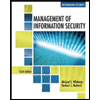According to the NIST Cybersecurity Framework, an organization can use the Framework as a key part of its systematic process for identifying, assessing, and managing cybersecurity risk. Based on your reading of the NIST Cybersecurity Framework, please select all the appropriate statement(s) that guide organizations on how the Framework can be used. 000 0 The Framework is not designed to replace existing processes; an organization can use its current process and overlay it onto the Framework to determine gaps in its current cybersecurity risk approach and develop a roadmap to improvement. The Framework is designed to complement existing business and cybersecurity operations. It can serve as the foundation for a new cybersecurity program or a mechanism for improving an existing program. The Framework is designed to completely replace existing cybersecurity management practices and requires that organizations start fresh when "moving to the framework" The Framework provides a means of expressing cybersecurity requirements to business partners and customers and can help identify gaps in an organization's cybersecurity practices.
According to the NIST Cybersecurity Framework, an organization can use the Framework as a key part of its systematic process for identifying, assessing, and managing cybersecurity risk. Based on your reading of the NIST Cybersecurity Framework, please select all the appropriate statement(s) that guide organizations on how the Framework can be used. 000 0 The Framework is not designed to replace existing processes; an organization can use its current process and overlay it onto the Framework to determine gaps in its current cybersecurity risk approach and develop a roadmap to improvement. The Framework is designed to complement existing business and cybersecurity operations. It can serve as the foundation for a new cybersecurity program or a mechanism for improving an existing program. The Framework is designed to completely replace existing cybersecurity management practices and requires that organizations start fresh when "moving to the framework" The Framework provides a means of expressing cybersecurity requirements to business partners and customers and can help identify gaps in an organization's cybersecurity practices.
Fundamentals of Information Systems
9th Edition
ISBN:9781337097536
Author:Ralph Stair, George Reynolds
Publisher:Ralph Stair, George Reynolds
Chapter10: Ethical, Legal, And Social Issues Of Information Systems
Section: Chapter Questions
Problem 2CE
Related questions
Question

Transcribed Image Text:17
18
19
According to the NIST Cybersecurity Framework, an organization can use the Framework as a key part of its systematic process for identifying, assessing, and managing
cybersecurity risk.
Based on your reading of the NIST Cybersecurity Framework, please select all the appropriate statement(s) that guide organizations on how the Framework can be used.
0 000
The Framework is not designed to replace existing processes; an organization can use its current process and overlay it onto the Framework to determine gaps in its
current cybersecurity risk approach and develop a roadmap to improvement.
The Framework is designed to complement existing business and cybersecurity operations.
It can serve as the foundation for a new cybersecurity program or a mechanism for improving an existing program.
The Framework is designed to completely replace existing cybersecurity management practices and requires that organizations start fresh when "moving to the
framework"
O O O O
The Framework provides a means of expressing cybersecurity requirements to business partners and customers and can help identify gaps in an organization's
cybersecurity practices.
One of the specific management activities and outcomes (framework core sub-category) within the NIST Cybersecurity Framework is "Physical devices and systems within the
organization are inventoried". Which Framework core Category incorporates this sub-category?
Asset Management (ID.AM)
Business
Environment (ID.BE)
Identity Management and Access Control (PR.AC)
Security Continuous Monitoring (DE.CM)
Select the statement(s) that accurately describe(s) the notion of "Framework Implementation Tiers" within the NIST Cybersecurity Framework.
O
Implementation Tiers describe describe the degree to which an organization's cybersecurity risk management practices exhibit the characteristics defined in the
Framework (e.g., risk and threat aware, repeatable, and adaptive).
The Tiers characterize an organization's practices over a range, from Partial (Tier 1) to Adaptive (Tier 4). These Tiers reflect a progression from informal, reactive
responses to approaches that are agile and risk-informed. That is, they describe an increasing degree of rigor and sophistication in cybersecurity risk management
practices.
Organizations should determine the desired Tier, ensuring that the selected level meets the organizational goals, is feasible to implement, and reduces cybersecurity risk
to critical assets and resources to levels acceptable to the organization.
All organizations must achieve the highest tier (Adaptive - Tier 4) at all costs regardless of organizational contexts as these tiers depict cybersecurity maturity levels.
Expert Solution
This question has been solved!
Explore an expertly crafted, step-by-step solution for a thorough understanding of key concepts.
This is a popular solution!
Trending now
This is a popular solution!
Step by step
Solved in 4 steps

Knowledge Booster
Learn more about
Need a deep-dive on the concept behind this application? Look no further. Learn more about this topic, computer-science and related others by exploring similar questions and additional content below.Recommended textbooks for you

Fundamentals of Information Systems
Computer Science
ISBN:
9781337097536
Author:
Ralph Stair, George Reynolds
Publisher:
Cengage Learning

Principles of Information Systems (MindTap Course…
Computer Science
ISBN:
9781285867168
Author:
Ralph Stair, George Reynolds
Publisher:
Cengage Learning

Management Of Information Security
Computer Science
ISBN:
9781337405713
Author:
WHITMAN, Michael.
Publisher:
Cengage Learning,

Fundamentals of Information Systems
Computer Science
ISBN:
9781337097536
Author:
Ralph Stair, George Reynolds
Publisher:
Cengage Learning

Principles of Information Systems (MindTap Course…
Computer Science
ISBN:
9781285867168
Author:
Ralph Stair, George Reynolds
Publisher:
Cengage Learning

Management Of Information Security
Computer Science
ISBN:
9781337405713
Author:
WHITMAN, Michael.
Publisher:
Cengage Learning,

Enhanced Discovering Computers 2017 (Shelly Cashm…
Computer Science
ISBN:
9781305657458
Author:
Misty E. Vermaat, Susan L. Sebok, Steven M. Freund, Mark Frydenberg, Jennifer T. Campbell
Publisher:
Cengage Learning